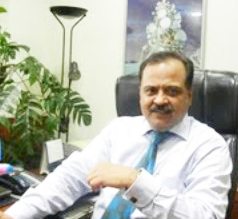Rohde & Schwarz (R&S) is a supplier of solutions in the fields of test and measurement, broadcasting, radio monitoring and radio location as well as mission-critical radio communications.
For more than 75 years, the company has been developing, producing and marketing a wide range of electronic products. Headquartered in Munich with subsidiaries and representatives active in over 70 countries around the world, Rohde & Schwarz has achieved its global presence greatly. Dilin Anand of EFY speaks to Yatish Mohan, managing director, Rohde & Schwarz India Pvt Ltd about the trends and challenges while working with the latest technologies.

Q. What are the different verticals that R&S focuses on?
A. Rohde & Schwarz has diversified product portfolio, which focuses on five verticals: Test & Measurement, Radio Communications, IT Security, Radio Monitoring, and Location and Broadcasting.
In Test & Measurement, we further define business segments as aerospace and defense, telecom, EMI/EMC test houses and Wide Based horizontal market segment which comprises mainly of general Electronics manufacturing & Educational and Research Institutes. Fortunately, India market space provides opportunities in all verticals with our diversified product portfolio.
Q. Could you elaborate on the challenges faced while designing next-gen products for each of those verticals?
A. The challenge is to have products with a platform to absorb new evolving technologies and form factor suitable for field usage and supporting easy portability. Multiple devices in one, larger memory capacity & longer battery power, high accuracy, compliant to highest safety standards and finally prices which are substantially lower than the traditional R&D Lab equipments.
For R&S, designing the products for each of the main verticals need knowledge in a diverse field encompassing Military technology, Broadcasting, and also latest telecom technologies like 3G and 4G.
Q. What are the challenges faced with respect to measurement while working with MM wave and terahertz frequency?
A. For measurements in microwaves and terahertz frequencies, the challenges are in maintenance of proper Environmental Lab conditions for complete 24 hour cycle. Supporting accessories & probes and also the local support in providing world class calibration facilities are other challenges for these frequency ranges.
For extending the measurement frequency, we use up converters for signal generation, which is available up to 110Ghz and down converters for Signal analysis which is available up to 500Ghz .The main challenge is to handle the very small connectors and test devices at such frequencies and also the accuracy of the measurement devices which are difficult to predict with a high level of certainty.
Q. Could you elaborate on the focus of the R&D center in India?
A. Customers still need a lot of test cases to be developed for R&D and network operator IOT testing and see R&S as a partner for the R&D signaling test case development. RS INDIA has set up its R&D centre in Bangalore to cater to the local needs of chipset and UE vendors, and network operators in India.
With high level of technical knowledge and domain expertise our skilled R&D engineers can develop test cases for our customers from L1 to L3 using MLAPI and LLAPI. This enables the customer to leverage on the core competence we have on the platform and also on the test case support for their own chipset/UE R & D. There is an added advantage for these customers as R & S as a single vendor takes the responsibility of the feature set on the platform as well as the test case.
Q. What are your views on modular instrumentation vs. traditional box type?
A. While PXIe and VXI technologies have been around for more than a decade now, customers still continue to show a strong preference for box type of test equipment. Main reason is that debugging of firmware and repair of Box type of equipment is far easier than the module. Having said this, certain niche industry like automation is witnessing good demand of PXI/VXI instrumentation. However, A&D and telecom industry’s demands are mostly met with box based solutions only.
We are aware that of late some PXI based solutions are introduced in telecom market however it is rather early to comment on their functionality as these devices are yet to be tested and accepted by users.
Q. Test & Measurement Equipment Management; how to best get it done?
A. Most of the T&M equipment are designed for lab usage, which requires a controlled operating temperature. The optimum performance of the equipment is specified in the range of 23 to 28 deg C, though most of the equipment is usable from 5 to 45 deg C. Regular calibration at recommended interval by the manufacturer (one/ two/ three years) would ensure that the equipment performs within specified limits.
R&S India has ISO 9001:2000 certified Quality Management Systems and ISO 17025 Accreditation by National Accreditation Board for Testing & Calibration Laboratories (NABL) for its Central Repairs & Calibration Laboratory in Bangalore, which helps customers to keep their instrument usable over the years, leading to controlled cost of ownership.
Q. What are the challenges faced while working with the new 802.11ac?
A. Today’s smartphones carry cellular and non-cellular technologies. The reason is that the number of mobile applications has grown along with the increased use of smartphones and tablets which has resulted in a huge rise in bandwidth demand. This demand is driven, to a large extent, by the popularity of streaming videos on smart phones and tablets.
For cellular providers, this increased demand has burdened their network capacity and found them wanting. The network operators are now slowly knocking off their unlimited usage plans and now going back to metered plans. This increased demand is also taxing the Wi-Fi network to supply sufficient bandwidth, especially as there are a large amount of powerful mobile handsets arriving on the market scene every day.






